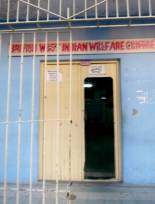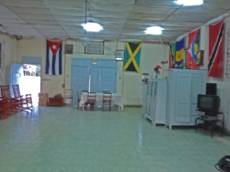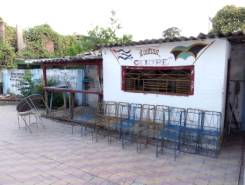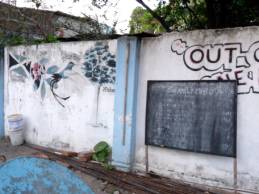|
|
THE BRITISH
WEST INDIAN WELFARE CENTRE
by Jenny Kassman -- June, 2009
For anyone living outside Cuba, the name Guantanamo will automatically
bring to mind the brutal, universally-condemned detention centre - an
abiding symbol of the Bush era - at the US naval base which, since 1903
has occupied about 45 square miles of Cuban territory and which most
people imagine to be the only presence of the contemporary
English-speaking world on the island. 
However, you only have to leave the base, cross the border and make your
way to Serafín Sánchez Street on the eastern outskirts of the Cuban city
of Guantánamo to find another link with the English-speaking world whose
presence has made and continues to make a significant contribution to the
history, as well as to the social and cultural life of Cuba.
The British West Indian Welfare Centre - known to locals as el Centre- was
founded in 1945 to provide a meeting place for the thousands of workers
from the English-speaking islands of the Caribbean (mainly Jamaicans) who
had come to Cuba during the early part of the 20th century to work on the
sugar and coffee plantations, found mainly in the eastern part of the
island. Although these workers had received a good basic education in
their own countries and were skilled tradesmen, they could only find work
on the island as casual labourers earning minimal wages.
In November 1933, the Cuban government of the time introduced the 50% Law
(La ley del 50%), according to which companies and landowners were obliged
to employ 50% Cuban nationals in their work force. As a result, many of
the English-speaking immigrant labourers who found themselves unemployed
gravitated to the city of Guantánamo in south-eastern Cuba to seek work at
the US naval base which was only too happy to employ English speakers.
 The Centre still occupies the building where it was inaugurated, in the
presence of the British Vice-Consul for Oriente Province. Adorning the
walls of the large hall, which serves as office, functions room and
archive are large flags representing all the islands in the
English-speaking Caribbean, together with the Cuban flag and the Union
Jack. Also on the walls are a cricket calendar, the words of the Jamaican
national anthem and photos of famous Jamaican and Cuban politicians. There
is a bookcase containing the Centre's archives as well as information
about the English-speaking Caribbean community. In one corner stands a
portable maypole. Behind the building is a large patio, also used for
meetings and other events. The Centre still occupies the building where it was inaugurated, in the
presence of the British Vice-Consul for Oriente Province. Adorning the
walls of the large hall, which serves as office, functions room and
archive are large flags representing all the islands in the
English-speaking Caribbean, together with the Cuban flag and the Union
Jack. Also on the walls are a cricket calendar, the words of the Jamaican
national anthem and photos of famous Jamaican and Cuban politicians. There
is a bookcase containing the Centre's archives as well as information
about the English-speaking Caribbean community. In one corner stands a
portable maypole. Behind the building is a large patio, also used for
meetings and other events.
El Centre has always occupied a special place in the life of the community
it serves. All the officers on the Board are volunteers and have full-time
jobs elsewhere. As the Culture Secretary, Onil Bientz Conte - a graphic
designer in his 30s and 4th generation descendent of immigrants from
Jamaica - explained: "Before the 1959 Revolution, Cuba was a profoundly
racist society in which all people of African descent, whether Cuban
nationals or immigrant workers, faced racial abuse, discrimination and
exploitation in all areas of their lives. They had no political
representation and a large percentage of the black community lived in
poverty, often extreme poverty, finding themselves marginalised from
mainstream Cuban society.. This Centre served as a place where they could
find support and re-affirm their identity and traditions in a hostile
social environment."
Until the Revolution, the centre also ran its own full-time primary school
where children wore a uniform and the teaching medium was English. It was
run by the grandmother of the current Secretary of the Centre, Sonia
Jackson Ming, a retired civil servant, and which Sonia herself attended.
"When I was a child, I always spoke English at home. My family was very
proud of their origins," explained Sonia, born in Cuba of a Jamaican
father and whose mother was born in Cuba of Jamaican parents. At 12 she
transferred to a Spanish-speaking secondary school. "It was a shock at
first, but I quickly found myself using Spanish quite naturally," she
said. English continues to figure prominently in her family: her brother
and niece are both English teachers. current Secretary of the Centre, Sonia
Jackson Ming, a retired civil servant, and which Sonia herself attended.
"When I was a child, I always spoke English at home. My family was very
proud of their origins," explained Sonia, born in Cuba of a Jamaican
father and whose mother was born in Cuba of Jamaican parents. At 12 she
transferred to a Spanish-speaking secondary school. "It was a shock at
first, but I quickly found myself using Spanish quite naturally," she
said. English continues to figure prominently in her family: her brother
and niece are both English teachers.
As was to be expected, many of the English-speaking workers settled down
and married Cubans. Sonia continued: “The handing down of the English
language from one generation to another depended very much on which parent
spoke English. The children of English-speaking mothers tended to converse
easily in the language. Those with only an English-speaking father tended
not to, their father being out at work for much of the time. If the
children lived with their English-speaking grandmother, they had no option
but to use English as their mother tongue.”
 The 1959 Revolution brought many important changes to the lives of
Afro-Cubans, summarised in the poem Tengo (‘I have’) by the famous
Afro-Cuban poet, Nicolás Guillén. Social divisions narrowed and society
became more integrated as free education and health care for all Cubans,
social benefits, workers' rights and land reforms were introduced. The 1959 Revolution brought many important changes to the lives of
Afro-Cubans, summarised in the poem Tengo (‘I have’) by the famous
Afro-Cuban poet, Nicolás Guillén. Social divisions narrowed and society
became more integrated as free education and health care for all Cubans,
social benefits, workers' rights and land reforms were introduced.
The standard of living of the poorest Cubans improved significantly. At
the same time racial discrimination was outlawed. As the social climate
changed, so Afro-Cubans felt there was less need for centres like the
Welfare Centre in Serafín Sánchez Street. and the membership declined as
the younger members moved away, leaving only the founding members. The
school disbanded as the pupils joined state schools.
This decline continued until the Special Period, which started in the
early 1990s, when Cubans suffered the effects of a severe economic crisis
brought on by the collapse of the USSR and socialist Eastern Europe,
together with the introduction in the US of the Torriccelli (Cuban
Democracy) Act in 1992 and the Helms-Burton Act in 1996. These two acts
led to a stringent tightening of the US blockade, first introduced in
1961. They affected other countries' ability to trade with the island, at
the precise time when Cuba needed to expand its markets. Once again,
finding themselves in need of support at a time of hardship and stress,
Afro-Cuban descendents of English speaking immigrants returned to the
Centre and the membership started to grow again.
Today, the Centre has 176 members, covering the full age range (the
average age being around 40) with a new generation keen to discover their
ancestral roots and to keep alive their cultural heritage.
Officers are chosen in elections which take place every two years and
members pay 1 peso (just over 1 pence) a month membership - cheap even by
Cuban standards.- and 2 pesos annually for health and welfare services
offered by the community. As Onil explained, "This centre has two
fundamental objectives: to give community support to those in need and to
serve as a cultural centre. Members visit the sick and help is given to
those who may need it, such as pensioners who need special food because of
a medical condition. When a member dies, there is support for the family
and the centre provides a wreath for the funeral.
 The strong commitment of the Centre to the welfare of its members is also
reflected by its future plans, envisaged by its perceptive, and tirelessly
hard-working director, Jorge Derrick Henry – an English teacher in his 50s
who works at a medical school in Guantánamo and whose parents/ancestors
came from Jamaica and Antigua. “My dream is to open a day centre for the
elderly here with social activities, exercise classes and a volunteer
nurse or doctor in attendance in the morning, followed by lunch and more
activities – all for a nominal charge,” he explained, adding that meals
should cost less than a peso.. Initially the day centre would be available
only to members of the BWIWC, but eventually Jorge would like to offer the
facility to the local community in general. He took me out to the patio,
indicating a bare patch of ground at the back that had a few bricks and
rubble strewn around. “If we can get funding, the kitchen will be here
with the roofing spanning the area from the toilets to the outer wall. In
front of the cooking area we’ll build a long counter for serving the
food,” he added. He went on to explain that, although there were very
cheap dining centres provided by the state across the island for the
elderly and the círculos de abuelos – groups that organise outings and
exercise for the same age group - there were few places that combined the
two kinds of facility.
The strong commitment of the Centre to the welfare of its members is also
reflected by its future plans, envisaged by its perceptive, and tirelessly
hard-working director, Jorge Derrick Henry – an English teacher in his 50s
who works at a medical school in Guantánamo and whose parents/ancestors
came from Jamaica and Antigua. “My dream is to open a day centre for the
elderly here with social activities, exercise classes and a volunteer
nurse or doctor in attendance in the morning, followed by lunch and more
activities – all for a nominal charge,” he explained, adding that meals
should cost less than a peso.. Initially the day centre would be available
only to members of the BWIWC, but eventually Jorge would like to offer the
facility to the local community in general. He took me out to the patio,
indicating a bare patch of ground at the back that had a few bricks and
rubble strewn around. “If we can get funding, the kitchen will be here
with the roofing spanning the area from the toilets to the outer wall. In
front of the cooking area we’ll build a long counter for serving the
food,” he added. He went on to explain that, although there were very
cheap dining centres provided by the state across the island for the
elderly and the círculos de abuelos – groups that organise outings and
exercise for the same age group - there were few places that combined the
two kinds of facility.
Equally impressive is the range of cultural activities run by the Centre.
Educational activities include talks on a variety of subjects, ranging
from engineering and health issues to literature and history. There are
workshops on the Anglo-Caribbean presence in Guantánamo, offered in
conjunction with the local authority, and English classes which are open
to everyone living in the locality. Inevitably the Centre runs family
history workshops for members wishing to trace family roots, in most cases
in Jamaica. A religious service is held each year on Easter Sunday, mainly
for the older members, and there is also a yearly memorial service for
members who have passed away.
 However, much of the centre’s cultural life focuses on the young although,
of course, all age groups enjoy the activities on offer. Because, as Onil
says, "It is the young people who will keep the interest in our culture
alive in the future." However, much of the centre’s cultural life focuses on the young although,
of course, all age groups enjoy the activities on offer. Because, as Onil
says, "It is the young people who will keep the interest in our culture
alive in the future."
The Centre has its own cricket team - one of seven on the island - which
takes part in yearly national tournaments and who are the current national
champions. The team has also played in Jamaica and is keen to plan more
fixtures abroad.
There are groups which perform traditional and modern styles of music and
dance, such as Calypso, Soca, Reggae, Mento and Ska and there is a monthly
peña de reggae (a group of reggae enthusiasts). A maypole dance also forms
part of the dance group's repertoire. One group, called Rainbow - all
amateurs with full-time jobs - performs in multi-cultural festivals, both
locally and nationally, where groups from the different communities that
make up the Cuban population, such as those with ancestors from Haiti,
China, the Middle East, Nigeria, the Congo and the English-speaking
islands of the Caribbean, as well as from different regions of Spain and
the Canary Islands, come together to enjoy each other's music, dance and
food.
Most popular are the celebrations held at the Centre with food, drink and
dancing to celebrate Mother's Day, Father's Day, St. Valentine's Day,
Children's Day, Xmas and any other occasion that can serve as an excuse
for a party.
 Needless to say, the Centre has attracted interest from many quarters.
Links are still maintained with the British government, which makes small
donations from time to time, as well as with governments, academics and
researchers from other English-speaking islands in the Caribbean and
beyond. Notwithstanding the diversity of origins among members and
visitors, the Centre sees itself above all as being part of what it is to
be Cuban - one of a number of widely differing cultures, all of which have
contributed to enrich the island's historical legacy and social and
cultural identity – a process known in Cuba as transculturación, which
continues to be strongly promoted and developed by the Cuban socialist
government.
Needless to say, the Centre has attracted interest from many quarters.
Links are still maintained with the British government, which makes small
donations from time to time, as well as with governments, academics and
researchers from other English-speaking islands in the Caribbean and
beyond. Notwithstanding the diversity of origins among members and
visitors, the Centre sees itself above all as being part of what it is to
be Cuban - one of a number of widely differing cultures, all of which have
contributed to enrich the island's historical legacy and social and
cultural identity – a process known in Cuba as transculturación, which
continues to be strongly promoted and developed by the Cuban socialist
government.
As I leave Jorge reaffirms the Centre’s position: “Our historical links
with the UK and the English-speaking world do not mean that we don’t see
ourselves first and foremost as Cubans and supporters of the Revolution.
Many visitors here think we are a chink in
Cuba’s armour which will enable them to report back negatively about our
socialist system. They are mistaken. We value the opportunities and
freedoms that the Revolution has made available to us and which are not
enjoyed by many communities on the other islands of the Caribbean. We do
not wish to see regime change in Cuba.”
|



